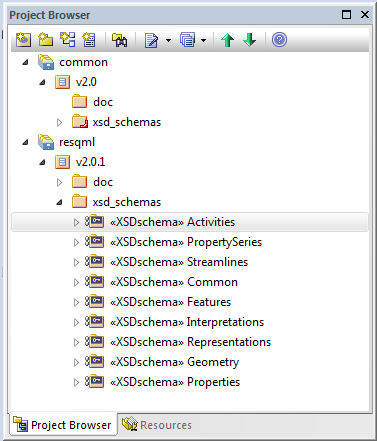14.1.5 Model Overview
| Topic Version | 1 | Published | 09/11/2015 | |
| For Standard | RESQML v2.0.1 | |||
The RESQML UML model is implemented and organized in an Enterprise Architecture Project (EAP) file, grouped into packages as shown in
The UML model is available as part of the RESQML download. To view the model you need Enterprise Architecture or EA Lite, a free reader available from the company that develops EA, at its website http://www.sparxsystems.com/.

Main packages of the RESQML UML model in EA are listed and described here.
common. Contains the classes that are used by all Energistics standards, which includes classes to consistently define base data objects and references, coordinate reference systems, and units of measure. For more information, see the Energistics common Technical Reference Guide. (For a link to this document, see 14.1.4.1 Energistics Resource Set.)
resqml, contains:
- The doc class (folder), which contains packages for:
- ClassDiagrams for the schema packages listed below (with the diagrams labeled appropriately). The class diagrams illustrate the attributes, inheritances, and the other relationships of the packages in the xsd_schemas class (folder).
- InstanceDiagrams with various examples for you to explore.
- The xsd_schema class (folder), which contains these packages:
- Activities (NEW in v2.0.1) to capture tasks or actions that occurred to create and edit a subsurface model, and how the activities relate to the data being exchanged.
- PropertySeries (NEW in v2.0.1) Makes it possible to capture the evolution of property values through time or for multiple realizations generated during stochastic processes.
- Streamlines (NEW in v2.0.1) In a reservoir engineering context, streamlines are a way to visualize and represent fluid flow. They have many applications; for example, they have been used as a basis for fluid flow simulation, sweep management, well rate optimization, and infill well placement.
- Common. Shared data objects and related objects. These data objects are shared across all packages in a RESQML project. Many objects are extensions of data objects that appear in the shared Energistics-wide common package.
- Features. Organized into two sub-packages—Geologic features and Technical features—this package contains all the classes that define the v2.0 business objects, which includes everything that needs to be defined to develop a subsurface model. Typical features include horizon, fault, geobody, wellbore, and many others.
- Interpretations. Contains all the classes that allow an interpreter to formalize his/her opinion of a feature. A typical example of interpretation is based on the opinion of the geometry of a feature. Other specific interpretation information may include the description of the throw of a fault, the horizon classification in a sequence stratigraphic approach, or the contacts in a structural model.
- Representations. Organized into four sub-packages—Structural, Grids, Seismic and Wells—this package contains all the supported topology, such as triangulation, fault stick, grids (2D grid, IJK grid, PEBI grid, unstructured grid, etc.
- Geometry. Geometry is attached to the indexable elements within a representation. Geometries are not RESQML top-level data objects so cannot be transferred independently.
- Properties. Properties are attached to the indexable elements of a representation. Properties are designed to be transferred independently of a representation, and are top-level data objects.
Section: Common